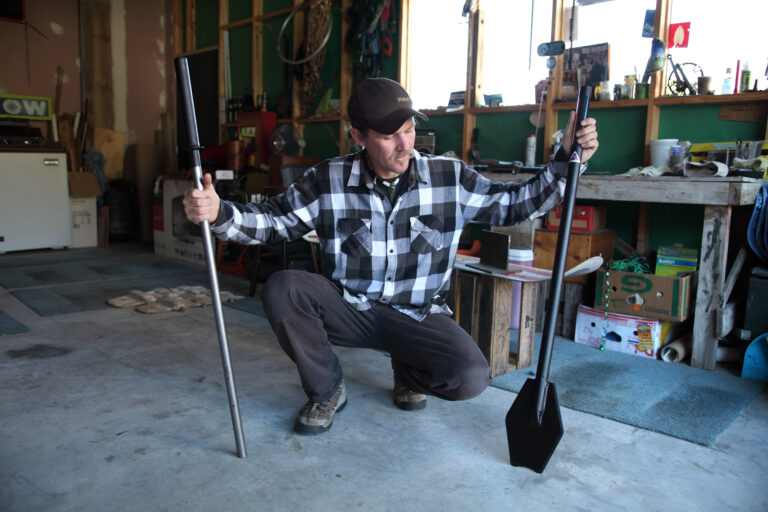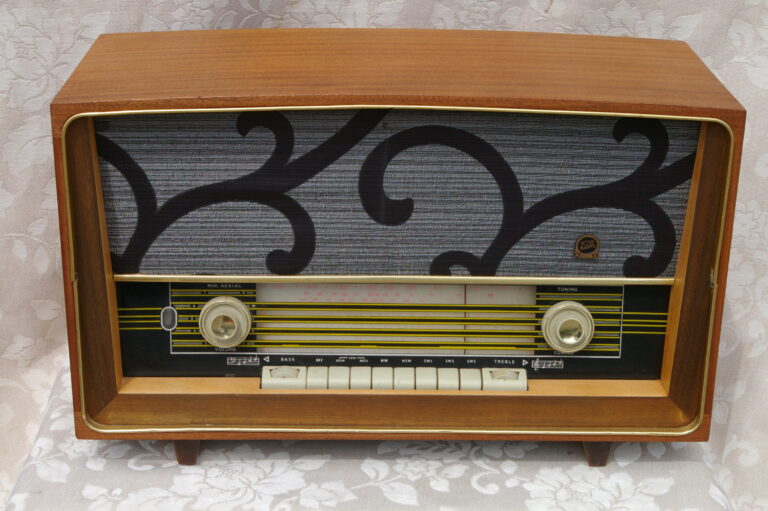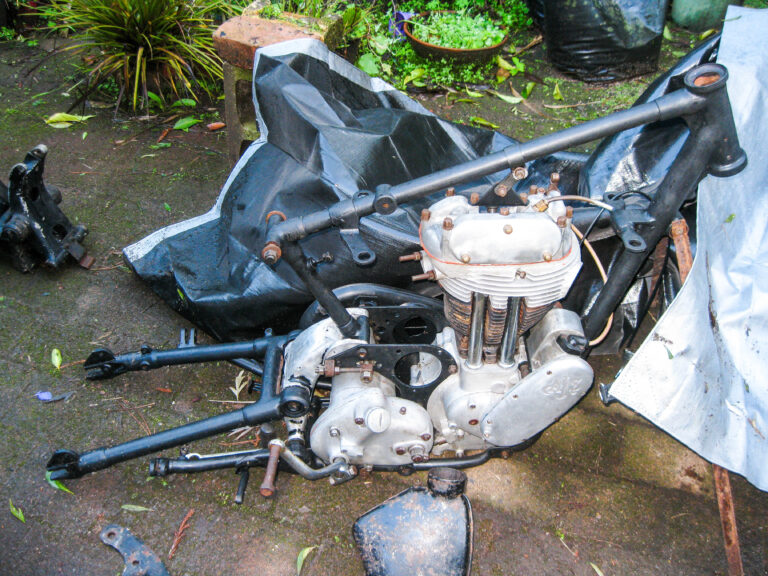A home-made ceramics kiln from an oil drum has lasted nine years without trouble
By Stephen Wealthall
Kiln in up position with new firebricks base. Winch handle is just visible top-left
Kiln down almost ready for firing (thermocouple yet to be inserted). Suspending wires are fixed to the rim shackles. Note drum lining overlap at the bottom.
Nothing vertical beats the excitement of opening a kiln and seeing the effect of naked flame on your creations. Gas kilns produce glaze finishes that are often unexpectedly beautiful but commercial gas kilns are usually expensive and bulky.
With some bought essentials, a cylinder of gas and a couple of weekends work you can make a kiln that will do initial (bisque or biscuit), glaze and raku firings and accommodate work of dimensions up to 700 mm high and 400 mm wide.
The chamber is a 40-gallon oil drum lined with ceramic fibre held in place by nichrome wire. Second-hand drum recyclers now talk only in litres but refer to drums as “equivalent to 40 gallons.” To fit on the octagon of firebricks, the drum should be approx 550 mm diameter. The drum I used is approximately 880 mm high and stainless steel (not essential, but substantial). The firebox is made of two cut kiln shelves surrounded by firebricks. One burner gives a temperature of approximately 1060º C and two around 1200º C. I have found that a hired 45 kg propane gas cylinder lasts 4-10 firings depending on temperature and time. The draught is regulated by pushing a piece of kiln shelf over a 150 mm flue hole.
The drum is raised by a pulley and winch for loading. This arrangement also allows easy unloading for raku firing, where the red-hot work is pulled from the kiln with tongs and placed in metal buckets containing leaves or sawdust to produce startling metallic finishes.
Temperature from a cheap thermocouple displays on a $10 multimeter.
Kiln down almost ready for firing (thermocouple yet to be inserted). Suspending wires are fixed to the rim shackles. Note drum lining overlap at the bottom
Preparing drum
Cut out the drum end which has the bunghole by running a cutter around inside the rim.
This open end will be the bottom of the kiln. In the centre of the other end that will be the top, cut a 150 mm diameter hole for the flue. To make a flue liner, use a strip of thin steel curved into a circle, notched and bent. Pop rivet or bolt the flue liner into the flue hole.
Around the rim of the top, drill three holes at 120 degrees apart from each other for attaching the shackles of the haul-up system. About halfway up the drum side, drill a 10 mm hole for the thermocouple. For holes to insert wires through to secure the lining, drill five columns of five rows of 3 mm holes in vertical lines around the drum and five holes radially in the top, halfway out from the flue.
Firebox when new, with interlocked firebricks and second shelf for firing small work
Firebox
Where you are going to place the firebox, position a beam at least 2.3 metres above the ground.
To this beam, securely attach a pulley for the wire that will raise and lower the kiln. I used old steel-wire rope from yacht rigging, strong enough to hold the weight of the drum, and a small second-hand winch of the type that hauls dinghies onto trailers. Note: Ensure the winch ratchet is really safe before loading or unloading. Level a site under-neath.
To create the firebox, cut off the corners of the large kiln shelf be-tween marks made at 130 mm in from each corner. This creates an octagon-shaped shelf. Push a fire-brick on edge against each of the four sides that have just been cut. The bricks should overlap by an equal distance at each end of the shelf side. Sit another four bricks on top of the lower bricks to bridge the lower bricks from corner to corner.
On the bottom of the top bricks, mark round where the brick corners sit. Square down the lines then cut the interlock shapes with a hacksaw. Check that the bricks interlock and butt snugly against the base kiln shelf (whole bricks on the long sides of the shelf) and then hole-saw or file one or two oblique burner holes in one or two of the whole bricks.
Author Stephen Wealthall with family help (and welding gloves) extracts hot glazed work for raku finishing.
Lining drum
To line the drum, you will need to wire the ceramic fibre blanket on with “buttons.”
From the remaining firebricks, hacksaw 30 “buttons” 10 mm thick and 20 mm wide and drill two 3 mm holes spaced 10 mm apart in the centre of each. Unless your wrists drag on the ground you will need help to fit the fibre blanket.
Cut a blanket length slightly larger than the inside circumference of the drum. Starting at the top, push in the fibre. The standard 610 mm-wide blanket will cover about 70 percent of the drum height in the first wrap. Now have the helper push uncut nichrome wire through the previously drilled holes in the drum and through the ceramic fibre, starting at the top.
From the inside, thread a button onto the wire. Using two pairs of pliers, bend a short “U” in the slack wire so it will fit into the second hole of the button. Using needle-nose pliers, the helper outside then pulls the wire tight and bends it into an “L” to retain the wire tightly against the outside of the drum.
Cut off the excess wire. Cut a second cylinder of fibre from the blanket and butt this firmly against the first. Overlap the blanket over the bottom edge of the drum by about 50 mm so that when the end of the fibre blanket is notched (use a craft knife) and flared outwards, the weight of the drum squashes it against the fire-bricks to make a tight seal.
Repeat the exercise with the wire, fixing this second section of the blanket inside the drum. Cut leftover kiln fibre to fit into the top of the drum so it is tight against the flue and the vertical fibre walls.
Secure the drum-top lining with nichrome wire.
Circular, notched steel flue cylinder. Note depth covers fibre-blanket thickness
Firebox
Where the firebox will sit, excavate the soil down 75 mm, tamp and level and fill the hollow to 25 mm deep with sand.
Leftover fibre can be used as an insulating base by making an octagon (base shelf + brick width) of ceramic fibre and placing it on the sand or directly on hard standing. Get the large kiln shelf centered exactly under the pulley position on the beam by using a plumb line. Make sure there is safe room for the firebricks, burners, and hoses.
Place the centred, base kiln-shelf on the fibre and sur-round it with the interlocked eight bricks. Ensure the lowered drum sits on the bricks evenly and is vertical and plumb below pulley.
Place gravel outside the firebricks to hold them in place.
Place four half-bricks face down in the middle to support the smaller shelf, which has its corners cut off at marks 115 mm from the corners to make an octagon.
Thermocouple in sheath. Note firebrick button to help keep wires apart
Assembly
Sit the drum rim on the firebricks (you may need a helper) and ensure that it lines up evenly all the way round. Attach the shackles around the top of the drum and arrange the wire rope so that the drum will hang vertically and clamp it in place. Site the winch and pulley(s) so that the drum hauls cleanly.
Ceramic fibre blanket lining and button placement. The nichrome wires are almost burnt through after nine years
Firing
Arrange the gas burner’s nozzle(s) just into the hole(s).
To make the burners and hoses safe I have bolt-ed them to house bricks and during firing lean a concrete block on the bricks. Connect the regulator to a propane cylinder. Raise the drum with the winch and carefully place your work on the shelf. Use a second kiln shelf and ceramic “legs” for lots of small work. Lower the drum carefully and check through the flue that the drum is centred and not touching the work. Insert the thermocouple in its sheath into the thermocouple hole and connect it to the multimeter, ensuring that the leads do not touch the kiln.
The thermocouple is inserted so it does not touch work when checked through the flue. The two wires of thermocouple MUST NOT touch inside the sheath – I separate then with wisps of ceramic fibre and a firebrick button.
If necessary, consult pottery literature and prepare the firing time-line on graph paper (1 mv from thermocouple = 25º C.). Ensure that the burner tap(s) are off, air vents on burners are about one-third open and the flue completely open.
Open the regulator on the cylinder, check for leaks (nose, liquid soap), turn the burner on only slightly and light. The first firing may produce fumes and it may be wise to wear a mask. Adjust the gas cylinder regulator burner tap(s) to achieve an appropriate rate of temperature rise.
The drum will get hot enough to burn severely so I wear welding gloves when very carefully peering obliquely through the flue, or adjusting the flue opening to be smaller (use a piece of kiln shelf to cover the flue) when higher temperatures are needed towards the end of a glaze firing. Then grab a comfortable chair, a drink and copy of The Shed magazine and wait for your artistic revelation.
I fire during the day and let the whole cool down overnight.
Burners lit but on minimal power for illustration. In this later model, the angle tip on the burner has been removed to fire the burner directly into the kiln for improved performance. Note burners are bolted to bricks for stability while granddaughter’s penguin family looks apprehensive.
PARTS LIST
40-gallon oil drum
Gas burners, pressure gauges, hoses, regulators
45 kg propane gas cylinder
Ceramic fibre blanket, 3.8 metres of 610 mm x 50 mm
3 metres of nichrome wire
12 firebricks, standard 230 x 115 x 75 mm
kiln shelf 460 mm square kiln shelf 406 mm square
Steel wire rope
Small winch
Three shackles, two wire rope grips
Nickel/chromium/nickel/aluminum thermocouple with ceramic sheath
Multimeter with a 200 mV (millivolt) range
* Specialist electrical suppliers or gas/kiln engineers can supply specialist parts. You may be able to get kiln shelves pre-cut to shape needed.



